A Democratic Leadership Style: More Effective Than Autocratic Style
VerifiedAdded on 2022/10/12
|9
|2263
|38
Essay
AI Summary
This essay examines the effectiveness of democratic leadership compared to autocratic leadership, arguing that the former is more beneficial for organizations. It presents supporting arguments for democratic leadership, such as increased employee motivation and involvement, leading to better team performance and decision-making. Counter-arguments regarding the control and efficiency offered by autocratic leadership are addressed and rebutted by highlighting the demotivating effects of excessive control and the long-term benefits of employee engagement. The essay concludes that while autocratic leadership may offer short-term gains in efficiency, the democratic style fosters a more creative and collaborative environment, ultimately leading to greater employee satisfaction and organizational growth. The document is available on Desklib, a platform offering AI-based study tools and solved assignments for students.
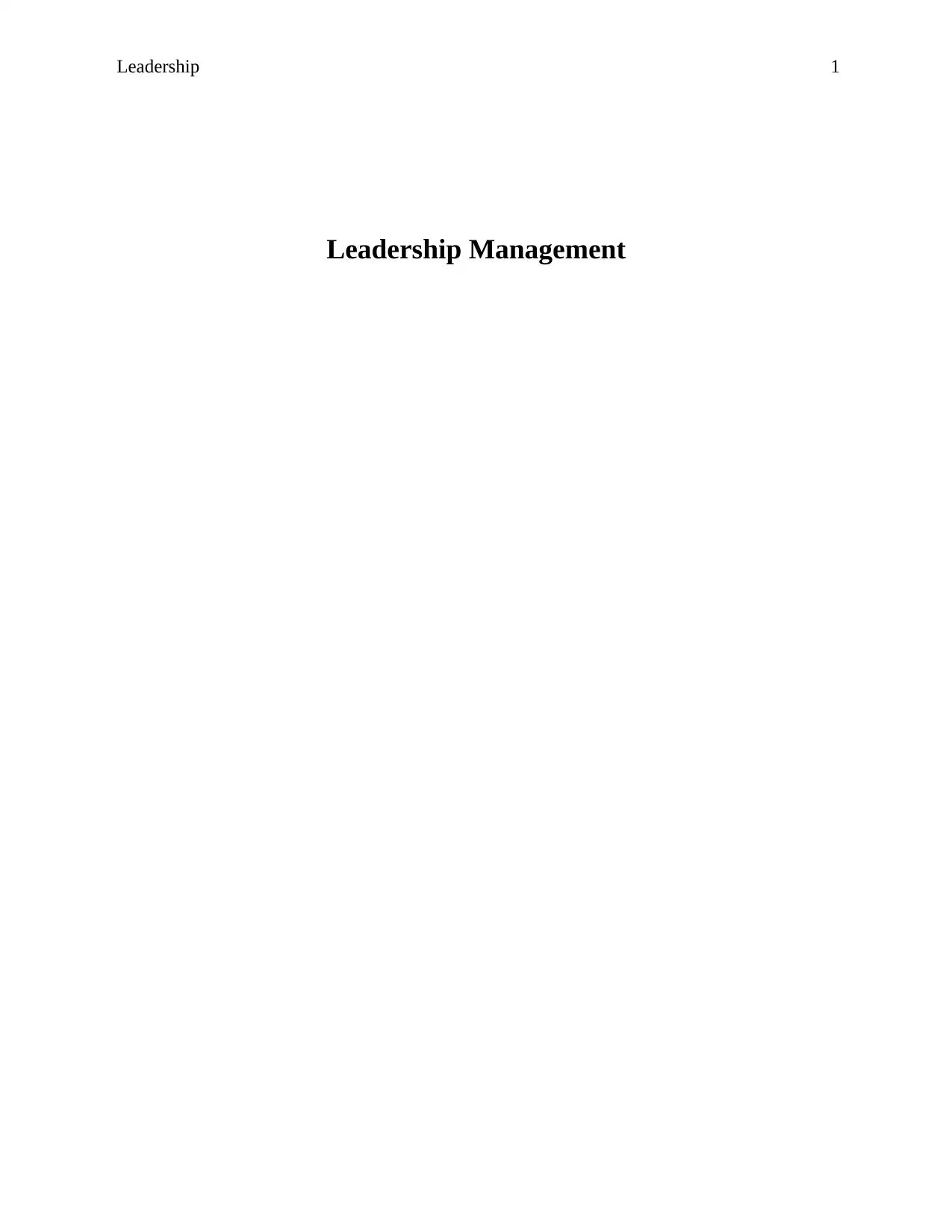
Leadership 1
Leadership Management
Leadership Management
Paraphrase This Document
Need a fresh take? Get an instant paraphrase of this document with our AI Paraphraser
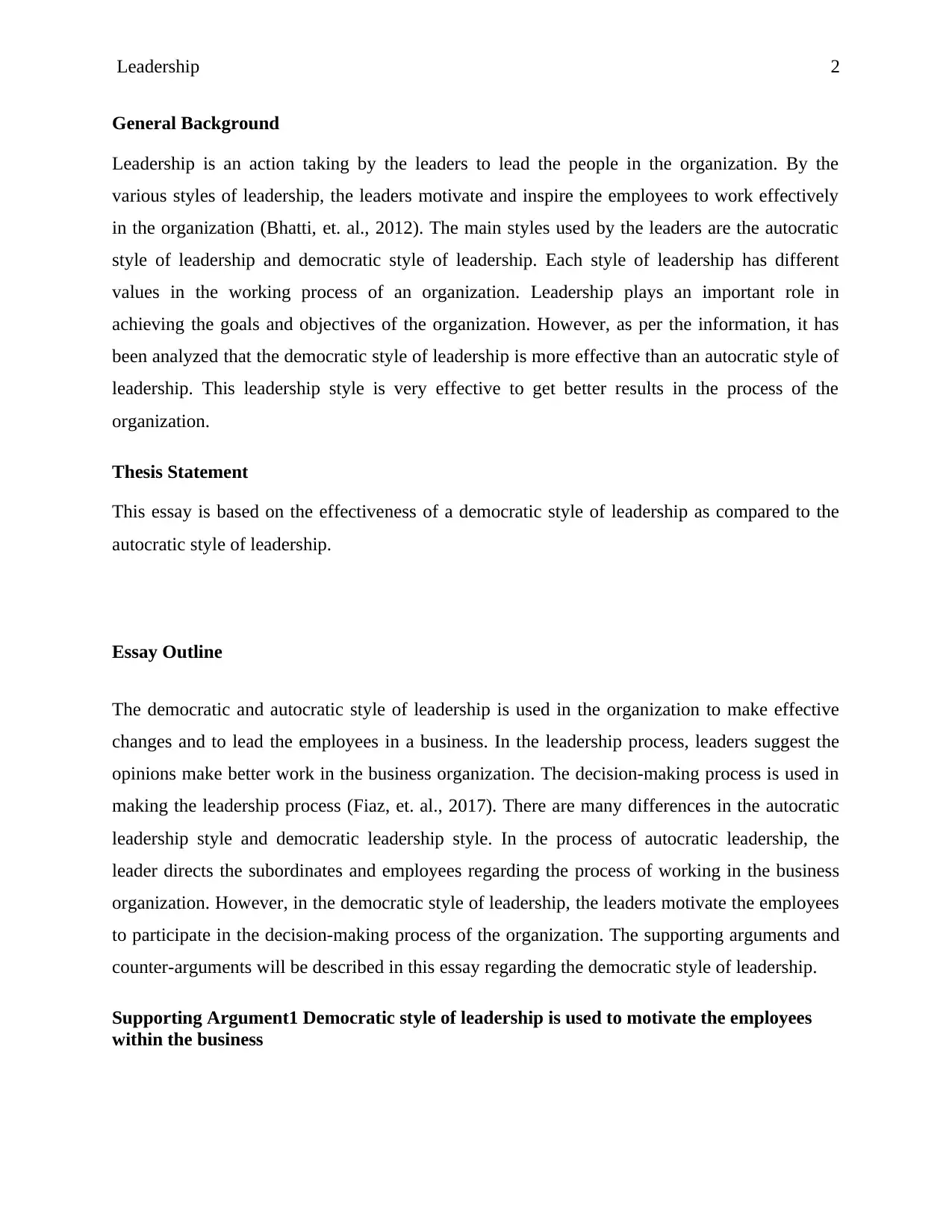
Leadership 2
General Background
Leadership is an action taking by the leaders to lead the people in the organization. By the
various styles of leadership, the leaders motivate and inspire the employees to work effectively
in the organization (Bhatti, et. al., 2012). The main styles used by the leaders are the autocratic
style of leadership and democratic style of leadership. Each style of leadership has different
values in the working process of an organization. Leadership plays an important role in
achieving the goals and objectives of the organization. However, as per the information, it has
been analyzed that the democratic style of leadership is more effective than an autocratic style of
leadership. This leadership style is very effective to get better results in the process of the
organization.
Thesis Statement
This essay is based on the effectiveness of a democratic style of leadership as compared to the
autocratic style of leadership.
Essay Outline
The democratic and autocratic style of leadership is used in the organization to make effective
changes and to lead the employees in a business. In the leadership process, leaders suggest the
opinions make better work in the business organization. The decision-making process is used in
making the leadership process (Fiaz, et. al., 2017). There are many differences in the autocratic
leadership style and democratic leadership style. In the process of autocratic leadership, the
leader directs the subordinates and employees regarding the process of working in the business
organization. However, in the democratic style of leadership, the leaders motivate the employees
to participate in the decision-making process of the organization. The supporting arguments and
counter-arguments will be described in this essay regarding the democratic style of leadership.
Supporting Argument1 Democratic style of leadership is used to motivate the employees
within the business
General Background
Leadership is an action taking by the leaders to lead the people in the organization. By the
various styles of leadership, the leaders motivate and inspire the employees to work effectively
in the organization (Bhatti, et. al., 2012). The main styles used by the leaders are the autocratic
style of leadership and democratic style of leadership. Each style of leadership has different
values in the working process of an organization. Leadership plays an important role in
achieving the goals and objectives of the organization. However, as per the information, it has
been analyzed that the democratic style of leadership is more effective than an autocratic style of
leadership. This leadership style is very effective to get better results in the process of the
organization.
Thesis Statement
This essay is based on the effectiveness of a democratic style of leadership as compared to the
autocratic style of leadership.
Essay Outline
The democratic and autocratic style of leadership is used in the organization to make effective
changes and to lead the employees in a business. In the leadership process, leaders suggest the
opinions make better work in the business organization. The decision-making process is used in
making the leadership process (Fiaz, et. al., 2017). There are many differences in the autocratic
leadership style and democratic leadership style. In the process of autocratic leadership, the
leader directs the subordinates and employees regarding the process of working in the business
organization. However, in the democratic style of leadership, the leaders motivate the employees
to participate in the decision-making process of the organization. The supporting arguments and
counter-arguments will be described in this essay regarding the democratic style of leadership.
Supporting Argument1 Democratic style of leadership is used to motivate the employees
within the business

Leadership 3
The democratic style of leadership is more effective as compared to the autocratic style of
leadership. As in the democratic style, leaders more involved with the employees and guide the
employees to get better results in the organization. The democratic style works for the better
performance of the overall team and gets better outcomes in the process. This style is all work
for the employees and makes them trained to take certain decisions regarding the better growth
of the organization (Somech, 2006). The performance of the employees becomes effective by
using this particular style of leadership. Team reflection and performance can be increased with
the help of the democratic style of leadership. The operations of the business become easier for
the employees as they become familiar with all the operations used by the business. The leaders
are very much engaged with the employees and make them friendly as per the requirements of
the business.
Supporting Argument 2 Democratic leadership is better as compared to the autocratic
leadership because of the more employees involved in the company due to this leadership
In the democratic leadership and autocratic leadership, democratic leadership is better because it
is a relation-oriented approach, which makes the employee effective in organizational decision-
making. Democratic leadership makes the employees involved in the business process and
employees give their ideas in the organizational performance and makes the environment as per
the employees so that they can do work with dedication (Anas-Al-Hai, 2017). By this leadership,
the employees become the members of the team and give their influence regarding the business
activities. The employee's suggestions make the overall process more effective. The democratic
leadership is participative leadership, which is better as compared to the directive leadership. The
employee-centric approach is better than the job centric so it is important to use the democratic
leadership on the place of autocratic leadership. The employees are the most important part of
the business so it is necessary to involve them in all the decisions. However, autocratic
leadership ensures efficiency in the production process but this leadership does not involve
employees in their process, which is not better for the organization, and it reduces the
organizational performance. Democratic leadership is more moderate and tender. This process
gives more value and care to the employee and analyzes their inspirations for the better growth
of the organization.
The democratic style of leadership is more effective as compared to the autocratic style of
leadership. As in the democratic style, leaders more involved with the employees and guide the
employees to get better results in the organization. The democratic style works for the better
performance of the overall team and gets better outcomes in the process. This style is all work
for the employees and makes them trained to take certain decisions regarding the better growth
of the organization (Somech, 2006). The performance of the employees becomes effective by
using this particular style of leadership. Team reflection and performance can be increased with
the help of the democratic style of leadership. The operations of the business become easier for
the employees as they become familiar with all the operations used by the business. The leaders
are very much engaged with the employees and make them friendly as per the requirements of
the business.
Supporting Argument 2 Democratic leadership is better as compared to the autocratic
leadership because of the more employees involved in the company due to this leadership
In the democratic leadership and autocratic leadership, democratic leadership is better because it
is a relation-oriented approach, which makes the employee effective in organizational decision-
making. Democratic leadership makes the employees involved in the business process and
employees give their ideas in the organizational performance and makes the environment as per
the employees so that they can do work with dedication (Anas-Al-Hai, 2017). By this leadership,
the employees become the members of the team and give their influence regarding the business
activities. The employee's suggestions make the overall process more effective. The democratic
leadership is participative leadership, which is better as compared to the directive leadership. The
employee-centric approach is better than the job centric so it is important to use the democratic
leadership on the place of autocratic leadership. The employees are the most important part of
the business so it is necessary to involve them in all the decisions. However, autocratic
leadership ensures efficiency in the production process but this leadership does not involve
employees in their process, which is not better for the organization, and it reduces the
organizational performance. Democratic leadership is more moderate and tender. This process
gives more value and care to the employee and analyzes their inspirations for the better growth
of the organization.
⊘ This is a preview!⊘
Do you want full access?
Subscribe today to unlock all pages.

Trusted by 1+ million students worldwide

Leadership 4
Paraphrase This Document
Need a fresh take? Get an instant paraphrase of this document with our AI Paraphraser

Leadership 5
Counter Argument 1 Organizational operations controlled more by the autocratic
leadership as compared to the democratic leadership
The leader has very high control over the several operations of the organization and the
democratic leaders of the organization do not do it. The control is good but as much control
affect the employees and create stress among the employees. The discipline is also at a very high
degree in autocratic leadership (Duan, et. al., 2017). However, it is effective in managing the
organization. However, sometimes the democratic leadership is not so effective in the
organizational and autocratic manages the business activities appropriately. Democratic leaders
easily give up in some critical situations. The high control of the autocratic leaders also gives the
stress to the employees but they work in pressure and increase the overall profit of the
organization, which improves the overall performance of the organization (Manza, 2017). The
operations also become effective while controlling them and improve the process of business.
Rebuttal to Counter- Argument 1 Control on the employees and operations demotivates
the employees and affect the performance of the organization
Control on the employees is effective but at some time only because unlimited control can
distract the mind of the employees and affect the performance of the business process. Extra
control creates demotivation among the employees and hampers their work quality and
dedication. There is a lack of support in the process of autocratic leadership; it is only effective
in the process of production itself (Schoel, et. al., 2011). The autocratic leaders do not adopt the
engagement of employee but it is necessary according to the long-term benefits of the
organization. The demotivation among the employees impact the overall performance of the
organization and it creates many difficulties in the organizational process. Democratic leaders
manage the free-flow of ideas and collaboration among the team management of the employees.
All the organizations need to maintain democratic leadership to get the proper benefits for the
business and to achieve desired goals and objectives. The overall performance of the
organization affects due to the demotivation of the employees creates by the autocratic
leadership which controls the overall operations of the organization (Cunningham, et.al., 2015).
Counter Argument 2 Autocratic leadership provides more efficiency and democratic to be
more moderate and tender
Counter Argument 1 Organizational operations controlled more by the autocratic
leadership as compared to the democratic leadership
The leader has very high control over the several operations of the organization and the
democratic leaders of the organization do not do it. The control is good but as much control
affect the employees and create stress among the employees. The discipline is also at a very high
degree in autocratic leadership (Duan, et. al., 2017). However, it is effective in managing the
organization. However, sometimes the democratic leadership is not so effective in the
organizational and autocratic manages the business activities appropriately. Democratic leaders
easily give up in some critical situations. The high control of the autocratic leaders also gives the
stress to the employees but they work in pressure and increase the overall profit of the
organization, which improves the overall performance of the organization (Manza, 2017). The
operations also become effective while controlling them and improve the process of business.
Rebuttal to Counter- Argument 1 Control on the employees and operations demotivates
the employees and affect the performance of the organization
Control on the employees is effective but at some time only because unlimited control can
distract the mind of the employees and affect the performance of the business process. Extra
control creates demotivation among the employees and hampers their work quality and
dedication. There is a lack of support in the process of autocratic leadership; it is only effective
in the process of production itself (Schoel, et. al., 2011). The autocratic leaders do not adopt the
engagement of employee but it is necessary according to the long-term benefits of the
organization. The demotivation among the employees impact the overall performance of the
organization and it creates many difficulties in the organizational process. Democratic leaders
manage the free-flow of ideas and collaboration among the team management of the employees.
All the organizations need to maintain democratic leadership to get the proper benefits for the
business and to achieve desired goals and objectives. The overall performance of the
organization affects due to the demotivation of the employees creates by the autocratic
leadership which controls the overall operations of the organization (Cunningham, et.al., 2015).
Counter Argument 2 Autocratic leadership provides more efficiency and democratic to be
more moderate and tender
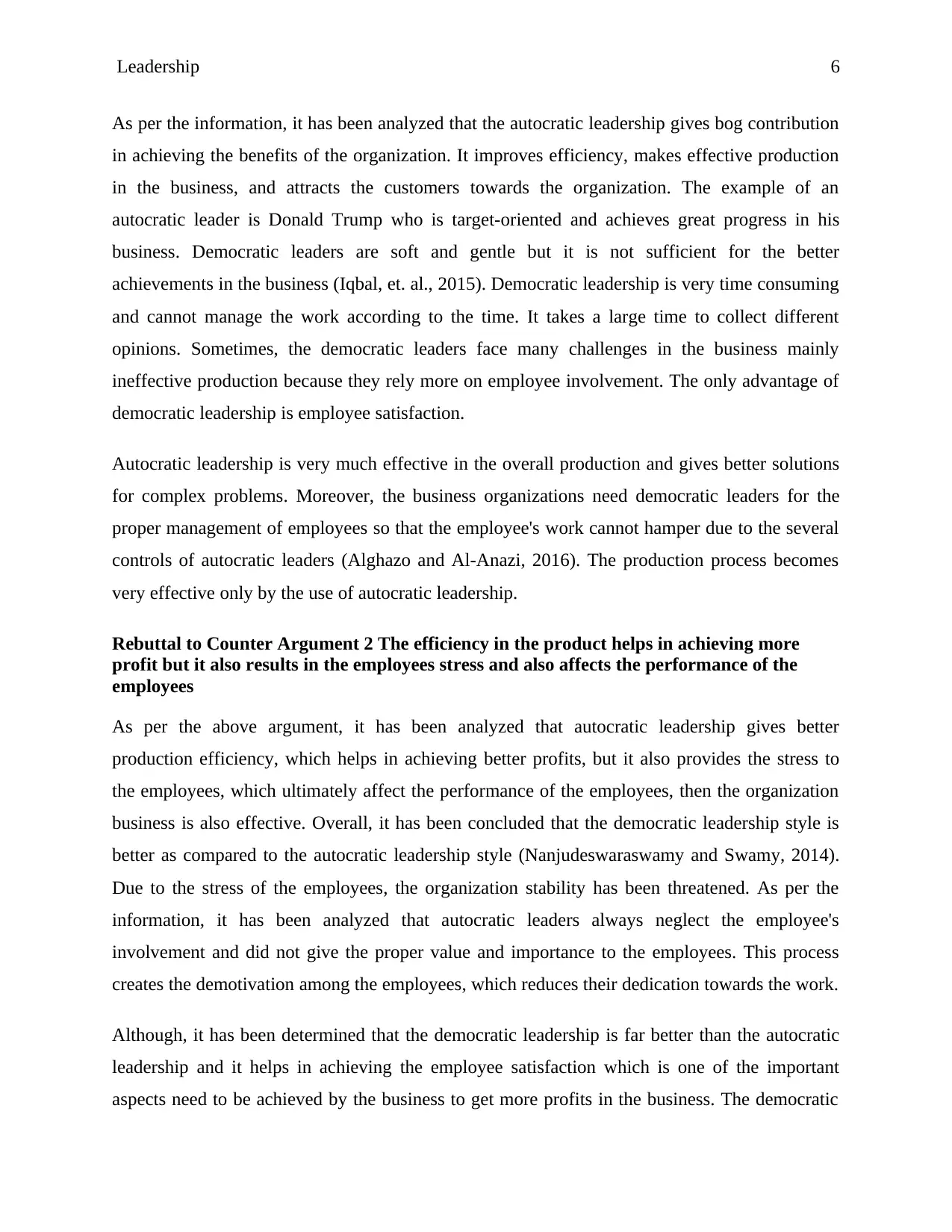
Leadership 6
As per the information, it has been analyzed that the autocratic leadership gives bog contribution
in achieving the benefits of the organization. It improves efficiency, makes effective production
in the business, and attracts the customers towards the organization. The example of an
autocratic leader is Donald Trump who is target-oriented and achieves great progress in his
business. Democratic leaders are soft and gentle but it is not sufficient for the better
achievements in the business (Iqbal, et. al., 2015). Democratic leadership is very time consuming
and cannot manage the work according to the time. It takes a large time to collect different
opinions. Sometimes, the democratic leaders face many challenges in the business mainly
ineffective production because they rely more on employee involvement. The only advantage of
democratic leadership is employee satisfaction.
Autocratic leadership is very much effective in the overall production and gives better solutions
for complex problems. Moreover, the business organizations need democratic leaders for the
proper management of employees so that the employee's work cannot hamper due to the several
controls of autocratic leaders (Alghazo and Al-Anazi, 2016). The production process becomes
very effective only by the use of autocratic leadership.
Rebuttal to Counter Argument 2 The efficiency in the product helps in achieving more
profit but it also results in the employees stress and also affects the performance of the
employees
As per the above argument, it has been analyzed that autocratic leadership gives better
production efficiency, which helps in achieving better profits, but it also provides the stress to
the employees, which ultimately affect the performance of the employees, then the organization
business is also effective. Overall, it has been concluded that the democratic leadership style is
better as compared to the autocratic leadership style (Nanjudeswaraswamy and Swamy, 2014).
Due to the stress of the employees, the organization stability has been threatened. As per the
information, it has been analyzed that autocratic leaders always neglect the employee's
involvement and did not give the proper value and importance to the employees. This process
creates the demotivation among the employees, which reduces their dedication towards the work.
Although, it has been determined that the democratic leadership is far better than the autocratic
leadership and it helps in achieving the employee satisfaction which is one of the important
aspects need to be achieved by the business to get more profits in the business. The democratic
As per the information, it has been analyzed that the autocratic leadership gives bog contribution
in achieving the benefits of the organization. It improves efficiency, makes effective production
in the business, and attracts the customers towards the organization. The example of an
autocratic leader is Donald Trump who is target-oriented and achieves great progress in his
business. Democratic leaders are soft and gentle but it is not sufficient for the better
achievements in the business (Iqbal, et. al., 2015). Democratic leadership is very time consuming
and cannot manage the work according to the time. It takes a large time to collect different
opinions. Sometimes, the democratic leaders face many challenges in the business mainly
ineffective production because they rely more on employee involvement. The only advantage of
democratic leadership is employee satisfaction.
Autocratic leadership is very much effective in the overall production and gives better solutions
for complex problems. Moreover, the business organizations need democratic leaders for the
proper management of employees so that the employee's work cannot hamper due to the several
controls of autocratic leaders (Alghazo and Al-Anazi, 2016). The production process becomes
very effective only by the use of autocratic leadership.
Rebuttal to Counter Argument 2 The efficiency in the product helps in achieving more
profit but it also results in the employees stress and also affects the performance of the
employees
As per the above argument, it has been analyzed that autocratic leadership gives better
production efficiency, which helps in achieving better profits, but it also provides the stress to
the employees, which ultimately affect the performance of the employees, then the organization
business is also effective. Overall, it has been concluded that the democratic leadership style is
better as compared to the autocratic leadership style (Nanjudeswaraswamy and Swamy, 2014).
Due to the stress of the employees, the organization stability has been threatened. As per the
information, it has been analyzed that autocratic leaders always neglect the employee's
involvement and did not give the proper value and importance to the employees. This process
creates the demotivation among the employees, which reduces their dedication towards the work.
Although, it has been determined that the democratic leadership is far better than the autocratic
leadership and it helps in achieving the employee satisfaction which is one of the important
aspects need to be achieved by the business to get more profits in the business. The democratic
⊘ This is a preview!⊘
Do you want full access?
Subscribe today to unlock all pages.

Trusted by 1+ million students worldwide
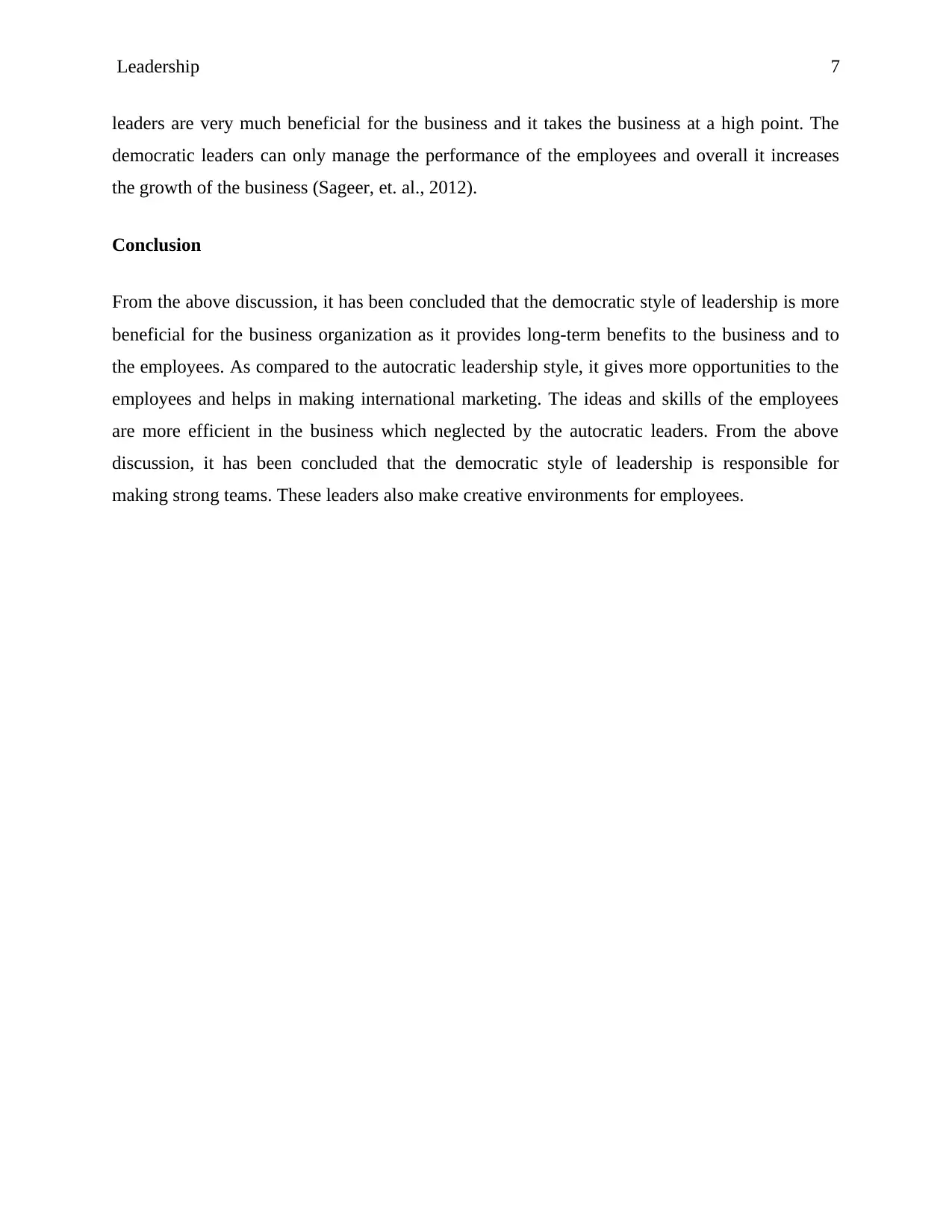
Leadership 7
leaders are very much beneficial for the business and it takes the business at a high point. The
democratic leaders can only manage the performance of the employees and overall it increases
the growth of the business (Sageer, et. al., 2012).
Conclusion
From the above discussion, it has been concluded that the democratic style of leadership is more
beneficial for the business organization as it provides long-term benefits to the business and to
the employees. As compared to the autocratic leadership style, it gives more opportunities to the
employees and helps in making international marketing. The ideas and skills of the employees
are more efficient in the business which neglected by the autocratic leaders. From the above
discussion, it has been concluded that the democratic style of leadership is responsible for
making strong teams. These leaders also make creative environments for employees.
leaders are very much beneficial for the business and it takes the business at a high point. The
democratic leaders can only manage the performance of the employees and overall it increases
the growth of the business (Sageer, et. al., 2012).
Conclusion
From the above discussion, it has been concluded that the democratic style of leadership is more
beneficial for the business organization as it provides long-term benefits to the business and to
the employees. As compared to the autocratic leadership style, it gives more opportunities to the
employees and helps in making international marketing. The ideas and skills of the employees
are more efficient in the business which neglected by the autocratic leaders. From the above
discussion, it has been concluded that the democratic style of leadership is responsible for
making strong teams. These leaders also make creative environments for employees.
Paraphrase This Document
Need a fresh take? Get an instant paraphrase of this document with our AI Paraphraser
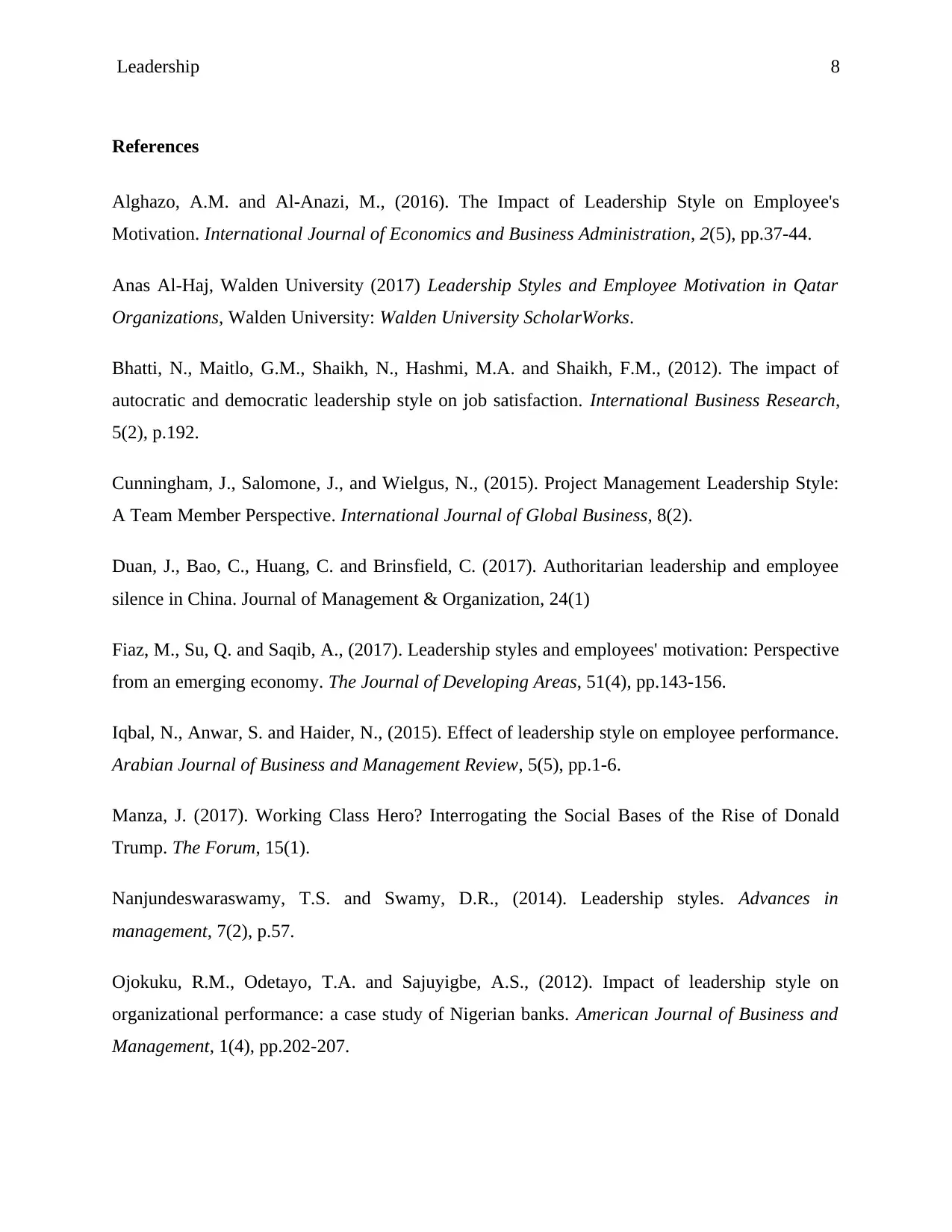
Leadership 8
References
Alghazo, A.M. and Al-Anazi, M., (2016). The Impact of Leadership Style on Employee's
Motivation. International Journal of Economics and Business Administration, 2(5), pp.37-44.
Anas Al-Haj, Walden University (2017) Leadership Styles and Employee Motivation in Qatar
Organizations, Walden University: Walden University ScholarWorks.
Bhatti, N., Maitlo, G.M., Shaikh, N., Hashmi, M.A. and Shaikh, F.M., (2012). The impact of
autocratic and democratic leadership style on job satisfaction. International Business Research,
5(2), p.192.
Cunningham, J., Salomone, J., and Wielgus, N., (2015). Project Management Leadership Style:
A Team Member Perspective. International Journal of Global Business, 8(2).
Duan, J., Bao, C., Huang, C. and Brinsfield, C. (2017). Authoritarian leadership and employee
silence in China. Journal of Management & Organization, 24(1)
Fiaz, M., Su, Q. and Saqib, A., (2017). Leadership styles and employees' motivation: Perspective
from an emerging economy. The Journal of Developing Areas, 51(4), pp.143-156.
Iqbal, N., Anwar, S. and Haider, N., (2015). Effect of leadership style on employee performance.
Arabian Journal of Business and Management Review, 5(5), pp.1-6.
Manza, J. (2017). Working Class Hero? Interrogating the Social Bases of the Rise of Donald
Trump. The Forum, 15(1).
Nanjundeswaraswamy, T.S. and Swamy, D.R., (2014). Leadership styles. Advances in
management, 7(2), p.57.
Ojokuku, R.M., Odetayo, T.A. and Sajuyigbe, A.S., (2012). Impact of leadership style on
organizational performance: a case study of Nigerian banks. American Journal of Business and
Management, 1(4), pp.202-207.
References
Alghazo, A.M. and Al-Anazi, M., (2016). The Impact of Leadership Style on Employee's
Motivation. International Journal of Economics and Business Administration, 2(5), pp.37-44.
Anas Al-Haj, Walden University (2017) Leadership Styles and Employee Motivation in Qatar
Organizations, Walden University: Walden University ScholarWorks.
Bhatti, N., Maitlo, G.M., Shaikh, N., Hashmi, M.A. and Shaikh, F.M., (2012). The impact of
autocratic and democratic leadership style on job satisfaction. International Business Research,
5(2), p.192.
Cunningham, J., Salomone, J., and Wielgus, N., (2015). Project Management Leadership Style:
A Team Member Perspective. International Journal of Global Business, 8(2).
Duan, J., Bao, C., Huang, C. and Brinsfield, C. (2017). Authoritarian leadership and employee
silence in China. Journal of Management & Organization, 24(1)
Fiaz, M., Su, Q. and Saqib, A., (2017). Leadership styles and employees' motivation: Perspective
from an emerging economy. The Journal of Developing Areas, 51(4), pp.143-156.
Iqbal, N., Anwar, S. and Haider, N., (2015). Effect of leadership style on employee performance.
Arabian Journal of Business and Management Review, 5(5), pp.1-6.
Manza, J. (2017). Working Class Hero? Interrogating the Social Bases of the Rise of Donald
Trump. The Forum, 15(1).
Nanjundeswaraswamy, T.S. and Swamy, D.R., (2014). Leadership styles. Advances in
management, 7(2), p.57.
Ojokuku, R.M., Odetayo, T.A. and Sajuyigbe, A.S., (2012). Impact of leadership style on
organizational performance: a case study of Nigerian banks. American Journal of Business and
Management, 1(4), pp.202-207.

Leadership 9
Sageer, A., Rafat, S. and Agarwal, P., (2012). Identification of variables affecting employee
satisfaction and their impact on the organization. IOSR Journal of business and management,
5(1), pp.32-39.
Schoel, C., Bluemke, M., Mueller, P. and Stahlberg, D. (2011). When autocratic leaders become
an option—Uncertainty and self-esteem predict implicit leadership preferences. Journal of
Personality and Social Psychology, 101(3), pp.521-540.
Somech, A., (2006). The effects of leadership style and team process on performance and
innovation in functionally heterogeneous teams. Journal of Management, 32(1), pp.132-157.
Sageer, A., Rafat, S. and Agarwal, P., (2012). Identification of variables affecting employee
satisfaction and their impact on the organization. IOSR Journal of business and management,
5(1), pp.32-39.
Schoel, C., Bluemke, M., Mueller, P. and Stahlberg, D. (2011). When autocratic leaders become
an option—Uncertainty and self-esteem predict implicit leadership preferences. Journal of
Personality and Social Psychology, 101(3), pp.521-540.
Somech, A., (2006). The effects of leadership style and team process on performance and
innovation in functionally heterogeneous teams. Journal of Management, 32(1), pp.132-157.
⊘ This is a preview!⊘
Do you want full access?
Subscribe today to unlock all pages.

Trusted by 1+ million students worldwide
1 out of 9
Related Documents
Your All-in-One AI-Powered Toolkit for Academic Success.
+13062052269
info@desklib.com
Available 24*7 on WhatsApp / Email
![[object Object]](/_next/static/media/star-bottom.7253800d.svg)
Unlock your academic potential
Copyright © 2020–2025 A2Z Services. All Rights Reserved. Developed and managed by ZUCOL.



